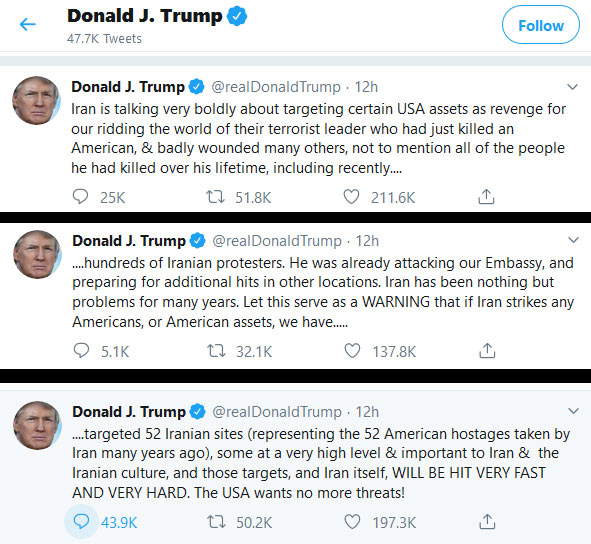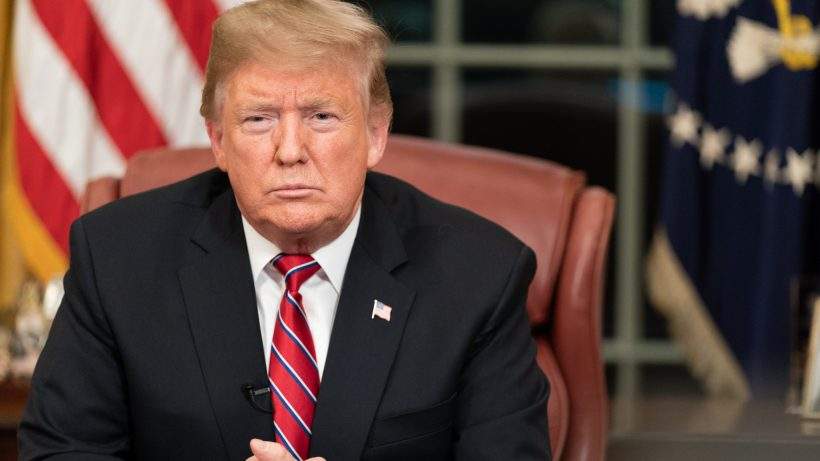U.S. President Donald Trump made very heavy statements tonight about his intentions towardIran. Theescalation of threats that has been triggered after the killing in a U.S. raid in Iraq of Iranian General Qasem Soleimani does not seem to stop, and tensions between the U.S. and Iran are at an all-time high: yesterday the Pasdaran, Iran’s Revolutionary Guards, through their commander Hossein Salami, threatened the U.S. by declaring that they had identified thirty-five U.S. targets in the region that could be hit.
Trump’s response was not long in coming: as many as fifty-two targets would be in the U.S. crosshairs (corresponding to the number of U.S. hostages captured at the U.S. Embassy in Tehran on Nov. 4, 1979, during the Islamic Revolution, and released after more than a year): “Iran,” President Trump wrote on Twitter, “has made very harsh statements about its intention to strike some U.S. targets as revenge for us ridding the world of their terrorist leader who had just killed one American, and seriously wounded many others, not to mention all those people he killed during his entire life, including hundreds of Iranian protesters. He was already ready to attack our embassy and was preparing for further raids on other locations. Iran has done nothing but create trouble for many years. Let the following serve as a warning: if Iran strikes any U.S. targets, we have identified 52 Iranian sites (symbolizing the 52 Americans taken hostage by Iran many years ago), some of them high-level, very important to Iran and Iranian culture, and these targets, and Iran itself, WILL BE HIT VERY QUICKLY AND VERY HARD. The U.S. wants no more threats!”
 |
| Trump’s tweets |
Of course, it is not known what cultural targets are being targeted by the Americans, nor is it clear what Trump means by sites “important to Iranian culture” (a White House spokesman whom the Daily Mail had asked for an explanation did not provide an answer), but it is necessary to note that international law is clear on the subject. The Geneva Convention, in Article 53 of the First Protocol, states that in the event of armed conflict it is forbidden to “engage in acts of hostility directed against historic monuments, works of art or places of worship, which constitute the cultural or spiritual heritage of peoples,” to “use said property in support of the military effort,” and to “make said property the object of reprisals.” And that’s not all: a 2017 U.N. resolution states that “unleashing unlawful attacks against sites and buildings dedicated to religion, education, art, science or charity, or against historical monuments, could constitute a war crime under certain circumstances and under international law, and that those responsible for such attacks may be brought to justice.” There is, after all, precedent for this: in 2016, the International Criminal Court in The Hague had handed down a sentence to a repentant former terrorist who deliberately destroyed monuments in Timbuktu, Mali (a UNESCO World Heritage city in its entirety).
Neither the United States nor Iran have ever ratified Protocol I of the Geneva Convention, but both were signatories to an important 1954 document (also cited in Article 53 of Protocol I), the Hague Convention for the Protection of Cultural Property in the Event of Armed Conflict, a treaty that came into being at the initiative of the Netherlands following the destruction they suffered during World War II and which decreed that, in the event of war, culture must be protected, prohibiting the use of force on cultural sites, preventing the plundering of cultural property in countries subject to conflict, requiring armed forces personnel to respect the culture of all peoples, and establishing the obligation on the part of the occupying power to preserve cultural property located in occupied territory.
Iran is one of the richest countries in the world in terms of culture, historical sites, monuments, ancient remains. In the World Heritage list, Iran ranks tenth with 24 sites, including cultural and natural sites (ironically, tied with the United States, which has 12 natural sites, 11 cultural sites, and one mixed site), behind Italy and China (which together lead the ranking with 55 sites), Spain, Germany, France, India, Mexico, the United Kingdom, and Russia, and ahead of countries such as Japan, Brazil, Canada, Australia, Greece, Turkey, and Portugal. Considering only cultural sites, Iran is ranked ninth.
The twenty-four Iranian sites are, in chronological order of entry on the list, Isfahan’s Naqsh-e jahán Square, the city of Persepolis, the ancient ziqqurat complex of Choqa zanbil, the shrine of Takht-e Soleyman, the city of Bam and its cultural landscape, the archaeological site of Pasargadae, the mausoleum of Soltaniyeh, the inscriptions of Bisotun, Armenian monastic settlements, the historic hydraulic system of Shushtar, the historic bazaars of Tabriz, the shrine of Sheikh Safī al-Dīn, the Persian gardens, Isfahan’s Friday Mosque, the city of Gonbad-e Kavus, the Golestan Palace, the site of Shahr-I Sokhta, the cultural landscape of Maymand, the city of Susa, the Persian qanat, the desert of Lut, the historic city of Yazd, the Sasanian archaeological landscape of the Fars region, and the Hyrcanian forests.
Trump’s statements apparently clash with what the president himself had said a few hours after the killing of Qasem Soleimani: in an official memo issued from his personal Mar-a-Lago mansion in Palm Beach, Florida, Trump had said that he “has deep respect for Iranians: they are an extraordinary people with an incredible historical heritage and unlimited potential. We are not looking for regime change. But the Iranian regime’s aggression in the region, including the use of proxy fighters to destabilize neighboring countries, must end, and it must end now.” Several analysts are already commenting on Trump’s words. These include Colin Kahl, a White House staffer during the Obama presidency and national security adviser in the vice president’s office also under Obama: he said in a tweet that “for what my opinion may be worth, I think it is hard to believe that the Pentagon would provide Trump with targets that include Iranian cultural sites. Trump may not care about the laws of war, but Defense Department officials and lawyers do, and hitting cultural sites is a war crime.”
 |
| Trump threatens to strike 52 targets in Iran, including cultural sites. But attacking culture is a war crime |
Warning: the translation into English of the original Italian article was created using automatic tools. We undertake to review all articles, but we do not guarantee the total absence of inaccuracies in the translation due to the program. You can find the original by clicking on the ITA button. If you find any mistake,please contact us.